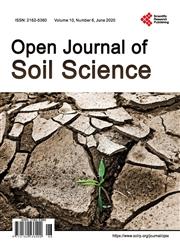Relationship between Selected Soil Physico-Chemical Characteristics and Mycorrhizal Status under Triumfetta cordifolia in the Cameroon Western Highlands
引用次数: 0
Abstract
There is limited information on the pedological requirements of Triumfetta cordifolia. A starting point for establishing such information requires knowledge on the growing environment of the species. The aim of this study was to assess the physicochemical properties and mycorrhizal status in the rhizosphere of Triumeffa cordifolia. Soil and root samples from the rhizosphere of T. cordifolia were collected from three localities (Santchou, Bandjoun, and Balatchi) in the West Region of Cameroon. The results show that the soils are dominated by a loamy texture and have a mean porosity > 50%. Mean bulk density ranges from 0.91 ± 0.02 to 1.26 ± 0.04 g⋅cm−3. The sum of exchangeable cations ranges from medium (6.45 ± 1.02) to high (11.21 ± 1.35) and are evident of the satisfactory soil organic matter (OM) content in the various localities (5.90% ± 0.42% to 10.65% ± 0.73%). Total nitrogen (TN) content of the soils ranged from low (0.10%) to very high (0.41%). Biological activity is low due to very poor OM quality (mean C/N > 20). The average available phosphorus status ranged from medium (18.32 ± 3.91 ppm) to very high (69.39 ± 26.09 ppm). The Cationic Exchange Capacity (CEC) was moderate (19.28 - 29.28 cmol⋅kg−1) and was mainly contributed by soil organic matter. Base saturation ranged from low (28.0%) to medium (48.83%). Assessment of endomycorrhizal colonization showed that the intensity (I), frequency (Fr) and specific density of spores (Ds) were not significantly different among sites. A high level of available P in the Santchou soils appears to be the major cause for the lowest values of Fr, I, and Ds observed. These results reaffirm the link between soil physicochemical properties and endomycorrhizal infection in T. cordifolia. Site characteristics and soil OM quality are factors to be considered in promoting the establishment of mycorrhizal symbiosis for profitable and sustainable cultivation of T. cordifolia.喀麦隆西部高地鸡心草下土壤理化特性选择与菌根状况的关系
关于鸡心草的土壤要求的信息有限。建立此类信息的起点需要了解物种的生长环境。本研究的目的是评估球茎植物Triumeffa cordifolia根际的理化性质和菌根状况。从喀麦隆西部地区的三个地方(Santchou、Bandjoun和Balatchi)采集了T.cordifolia根际的土壤和根系样本。结果表明,土壤以壤土为主,平均孔隙度>50%。平均堆积密度范围为0.91±0.02至1.26±0.04 g·cm−3。交换性阳离子的总量从中等(6.45±1.02)到高(11.21±1.35)不等,各地区的土壤有机质含量(5.90%±0.42%到10.65%±0.73%)令人满意。土壤总氮含量从低(0.10%)到极高(0.41%)不等。由于有机质质量非常差(平均C/N>20),生物活性较低。平均有效磷含量从中等(18.32±3.91ppm)到极高(69.39±26.09ppm)不等。阳离子交换容量(CEC)中等(19.28-29.28 cmol·kg−1),主要由土壤有机质贡献。基质饱和度从低(28.0%)到中等(48.83%)不等。对菌根定殖的评估表明,不同地点孢子的强度(I)、频率(Fr)和比密度(Ds)没有显著差异。Santchou土壤中高水平的有效磷似乎是观测到的Fr、I和Ds值最低的主要原因。这些结果重申了土壤理化性质与T.cordifolia菌根感染之间的联系。场地特征和土壤OM质量是促进菌根共生关系建立的因素,有利于堇叶的盈利和可持续种植。
本文章由计算机程序翻译,如有差异,请以英文原文为准。
求助全文
约1分钟内获得全文
求助全文

 求助内容:
求助内容: 应助结果提醒方式:
应助结果提醒方式:


